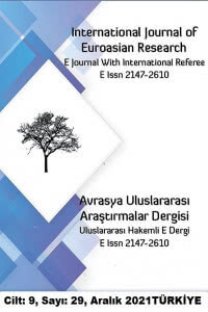EİSENHOWER DOKTRİNİ ÇERÇEVESİNDE BÖLGESEL KRİZLER: SURİYE- IRAK-ÜRDÜN-LÜBNAN
REGIONAL CRISES WITHIN THE FRAMEWORK OF EISENHOWER DOCTRINE: SYRIA-IRAQ-JORDAN-LEBANON
___
- Almog, Orna. 2002. Britain, Israel and the United States 1955-1958: Beyond Suez. Taylor & Francis.
- Altunışık, B. Meliha. 2007. “Lübnan Krizi: Nedenleri ve Sonuçları”. TESEV. http://tesev.org.tr/wp- content/uploads/2015/11/Lubnan_Krizi_Nedenleri_Ve_Sonuclari.pdf adresinden alındı
- Armaoğlu, Fahir. 1995. “Orta Doğu Komutanlığı’ndan Bağdat Paktı’na 1951–1955”. Belleten, 191-236.
- Armaoğlu, Fahir. 2005. 20.Yüzyıl Siyasi Tarihi 1914-1995. Alkım Yayınları.
- Ashton, N. James. 1996. Eisenhower, Macmillan and the Problem of Nasser. Palgrave Macmillan UK.
- Ayın Tarihi. 1951, Aralık 19.
- Barret, Roby. 2008. “Intervention in Iraq, 1958-1959”. The Middle East Institute Policy Brief, 11Nisan.
- Barrett, Roby. 2007. The Greater Middle East and the Cold War: US Foreign Policy Under Eisenhower and Kennedy. I.B.Taurius.
- Blackwell, Stephen. 2009. British Military Intervention and the Struggle for Jordan: King Hussein, Nasser and the Middle East Crisis, 1955-1958. Routledge.
- Campbell, C., John. 1960 Defense Of The Middle East: Problems Of American Policy. Harper&Brothers, New York.
- “Charting a Difficult Course: Jordan in the 1950s”. tarih yok. http://www.kinghussein.gov.jo/his_periods1.html. Erişim Tarihi: 11 Şubat 2021.
- Cohen, Michael, J. 2005. Strategy and Politics in the Middle East, 1954–1960: Defending the Northern Tier. New York: Frank Cass.
- Divine, Robert. A. 1981. Eisenhower and the Cold War. Oxford University Pres.
- Duman, Sabit. 2005. Ortadoğu Krizleri ve Türkiye. Ankara Üniversitesi Türk İnkılâp Tarihi Enstitüsü Atatürk Yolu Dergisi, Mayıs-Kasım35-36, 313-332.
- Dursun, D. 1991. “Bağdat Paktı”. İslam Ansiklopedisi, https://islamansiklopedisi.org.tr/bagdat-pakti. Erişim Tarihi: 27 Aralık 2018.
- Ecevit, Bülent. 1957: 3, Mart 13. “Bağdat Paktı ve Eisenhower Doktrini”. Ulus.
- Eisenhower, Dwight D. 1965. Waging Peace 1956-1961. Doubleday Company, New York.
- Erkmen, Serhat. 2008. “1945-1989 Yılları Arasında ABD’nin Kuzey Irak Politikası”. Akademik Orta Doğu5, 66-96.
- Fowler, Randall and Martin J. Medhurst. 2018. More Than a Doctrine: The Eisenhower Era in the Middle East. University of Nebraska Press.
- G.L. 1957. “Suez and Its Consequences: The Israel View. The World Today”, 134, 152- 161. https://www.jstor.org/stable/40392971.
- Gendzier, Irene. L. 2006. Notes from the Minefield: United States Intervention in Lebanon, 1945-1958. Columbia University Press.
- Gerger, Haluk. 2006. ABD Ortadoğu Türkiye, İstanbul. İstanbul: Ceylan Yayınları.
- Gültekin, Sümer. 2008. “Amerikan Dış Politikasının Kökenleri ve Amerikan Dış Politik Kültürü”. Uluslararası İlişkiler, 519, 119-144.
- Gürün, Kamuran. 1983. Dış İlişkiler ve Türk Dış Politikası: 1939'dan Günümüze Kadar. AÜSBF Yayınları.
- Hahn, Peter L. 2006. “Securing the Middle East: The Eisenhower Doctrine of 1957”. Presidential Studies Quarterly, vol. 36, no. 1, [Wiley, Center for the Study of the Presidency and Congress], 2006, pp. 38–47.
- Hart, Liddell, B. 2003. Strateji Dolaylı Tutum. S. Koçak, Çev. İstanbul: Doruk Yay.
- History State. t.y. “The Suez Crisis, 1956”. https://history.state.gov/milestones/1953- 1960/suez; https://www.britannica.com/event/Suez-Crisis.
- Hitti, K. Philip. 1959. Syria: A Short History 1959. New York: The Macmillan Company. I.R.Blean. 2008. Iraq in Crisis. Florida; USA: Rourke Publishing.
- John Worrall, R. 2007. “Coping with a Coup d'Etat’: British Policy towards Post- Revolutionary Iraq, 1958–63”. Contemporary British History, 212, 173–199.
- Kettle, Louise. "4 Suez in Reverse – Kuwait 1961". Learning from the History of British Interventions in the Middle East, Edinburgh: Edinburgh University Press, 2022, pp. 90- 128.
- Kirk, George. 1960. “The Syrian Crisis of 1957-Fact and Fiction”. International Affairs Royal Institute of International Affairs 1944-, 361.
- Kyle, K., & Loui, R. W. 2011. Suez: Britain’s End of Empire in the Middle East. I.B.Taurius.
- McDougall, Walter. A. 1997. “Back to Bedrock: The Eight Traditions of American Statecraft”. Foreign Affairs, 762, 134-146.
- McDougall, Walter. A. 2009. “U.S. Foreign Policy Traditions And The Middle East”. The Newsletter of the Wachman Center, 1417. https://www.fpri.org/article/2009/07/u-s- foreign-policy-traditions-and-the-middle-east/.
- Merriam-Webster Dictionary. 2006. “Meliorism”. doi:https://www.merriam- webster.com/dictionary/meliorism.
- Murat Turgay. 2012. “Mısır ekseninde Ortadoğu'da Amerika - Sovyet Rusya mücadelesi 1945-1973”. Fırat Üniversitesi Basılmamış Doktora Tezi.
- Piotrow, Piotr. 1958. “Nasser and Arab Unity”. Editorial research reports 1958 Vol. I. http://library.cqpress.com/cqresearcher/cqresrre1958060400 .
- Riedel, Buruce. 1958. “When America first went to war in the Middle East”. https://www.brookings.edu/blog/order-from-chaos/2018/07/02/1958-when-america-first- went-to-war-in-the-middle-east/ .
- SETA. 2006. “Lübnan’da İstikrar Arayışları.” SETA Lübnan Raporu, Proje Koordinatörü: Talha Köse, Aralık 2006, SETA. Talha Köse.
- Sever, Ayşegül. 1997. Soğuk Savaş Kuşatmasında Türkiye Batı ve Orta Doğu 1945– 1958. Boyut Yayınları.
- Seydi, Süleyman. 2011. “Demokrat Parti’nin Diş Politikada Alternatif Arayışı 1957– 1960”. Süleyman Demirel Üniversitesi Sosyal Bilimler Enstitüsü Dergisi, 214.
- Sorby, Karol. R. 2000. “Lebanon: The Crisis Of 1958”. Asian And African Studies, 91, 76-109.
- Tal, Lawrence. 1995. “Britain and the Jordan Crisis of 1958”. Middle Eastern Studies, 311. http://www.jstor.org/stable/4283698.
- Traboulsi, Fawwaz. 2007. A History Of Modern Lebanon. London: Pluto Press.
- Turan, Namık. S. 2011. “Lübnan’da Ulusun İnşası ve Ortak Tınının Üretimi – Rahbani Kardeşler ve Feyruz”. Ortadoğu Etütleri, 31.
- Uçarol, Rıfat. 2000. Siyası Tarih 1789 – 1999. İstanbul: Filiz Kitabevi.
- United Nations Peacekeeping. t.y.. Middle East, UNEF-1: https://peacekeeping.un.org/en/mission/past/unef1backgr1.html . Erişim Tarihi: 12 Ocak 2019.
- Uslu, Nasuh. 2000. Türk Amerikan İlişkileri. Ankara: 21. Yüzyıl Yayınları.
- Yakut, K., & Yakut, Esra. 2013. “Siyasi Tarih Unite II.” içinde İ. Ortaylı ed.. Eskişehir Anadolu Üniversitesi, Açık Öğretim Fakültesi Yayınları.
- Ziyadeh, Radwan. 2011. Power and policy in Syria. London: I.B. Tauris.
- ISSN: 2147-2610
- Yayın Aralığı: 4
- Başlangıç: 2012
- Yayıncı: Kürşat Öncül
ŞİKÂYET DEFTERLERİ VE BELGELERİ ÇÖZÜMLENMESİNE ALGORİTMASAL BİR YAKLAŞIM
MİLLİ TEMİNAT ANDI VE CUMHURBAŞKANI İSMET İNÖNÜ’NÜN 30 TEMMUZ-22 AĞUSTOS 1949 TARİHLİ EGE GEZİSİ
BÜYÜK DEVLETLERİN KAFKASYA’DA DEMİRYOLU VE PETROL POLİTİKASI
FUZÛLÎ’NİN TÜRKÇE GAZELLERİNDE KUR’ÂN-I KERÎM’DEKİ DİNÎ ŞAHSİYETLER
GİRİT İSYANI’NDA YUNAN GÖNÜLLÜLER (1866-1869)
TÜRKİYE'DE YEREL YÖNETİMLERİN EĞİTİME KATKILARI
DIŞ GELİŞMELER IŞIĞINDA CUMHURBAŞKANI İSMET İNÖNÜ'NÜN İKİNCİ DÜNYA SAVAŞI DÖNEMİ İSTANBUL ZİYARETLER
ULUSLARARASI SİSTEMDE “ÖTEKİ”NİN KİMLİK ANALİZİNE DAİR: BİZ’E KARŞI “ONLAR”
